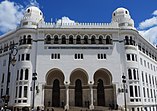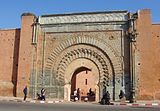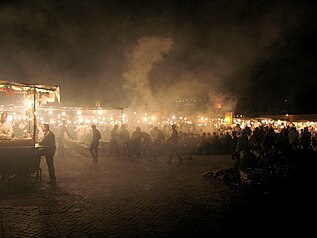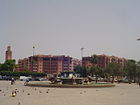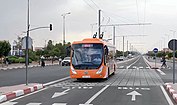Maktarim
Maktarim
ⵎⴰⴽⵜⴰⵔⵉⵎ | |
|---|---|
Capital | |
| |
| Country | Talahara |
| Region | Rubric Coast Centre |
| Superior Council Regions | List
|
| Founded | c. 3800 BCE |
| Government | |
| • Type | Urban association |
| • Body | Maktarim 9 Consortium |
| Area | |
| • Capital | 823 km2 (318 sq mi) |
| • Metro | 16,618 km2 (6,416 sq mi) |
| Highest elevation | 375 m (1,230 ft) |
| Lowest elevation | 0 m (0 ft) |
| Population (2018) | |
| • Capital | 8,873,785 |
| • Density | 11,000/km2 (28,000/sq mi) |
| Demonym | Maktariman |
| Postal code | MAK1-01 to MAK9-50 |
| Area code(s) | 318 and 429 |
Maktarim (Takelat: ⵎⴰⴽⵜⴰⵔⵉⵎ) is the capital and largest city of the Talaharan Commune with a population of 8,873,785 as of the 2022 census. It is located on the coast of Juga Bay in the Periclean sea.
The city proper extends 823 km2 (318 sq mi) but its commonly denoted metropolitan area extends approximately 16,618 km2 (6,416 sq mi). Maktarim is at the core of the Rubric Coast Megalopolis, with over 95% of the country's population living along the northern coastline.
Maktarim is a transportation and service hub. It is the financial, political, and transportation core of Talahara. In addition, it is home to a number of culturally significant monuments and festivals.
History
Geography and climate
Maktarim is a coastal city on the Periclean. The urban centre and metropolitan area arc around Juga Bay and around the mouth and delta of the Mekwisan River. The topography varies between hills and cliffs along the coast to the west and flatter beaches to the east. The tallest point in the city is Lamnadar Hill in the Maktarim-Laɣrab at 375 m.
The climate of the city is hot and semi-arid, lightly mediated by the Periclean. Summers are hot and usually dry with short, mild winters. Transitional seasons bring greater humidity before temperatures fall, leading to extreme mugginess. On average, only 57 out of 365 days of the year experience rain. The Mekwisan's delta rarely fills and many of the tendrils of the river are dry save for during extreme floods. The different paths, both dry and wet, separate many of the city's council regions.
Cityscape
Outside of the urban centre, population density falls off rapidly. The six districts that make up Maktarim-proper average at over a million population each and are further subdivided into wards. The Waterfront and Murabbaɣ Centre districts are the economic centres and feature the most modernist urban development. The other districts and much of the outlying metropolitan communities are bedroom communities with mixed development and economic activity.
Demographics
As of 2022, Maktarim has a population of 8,873,785 within its urban centre. The total population living in the metropolitan area exceeds 12 million while the megalopolitan area includes up to 50 million. Maktarim is the largest city in Talahara and one of the largest metropolises in northern Scipia and the world. Approximately 47.3% of the population identify as male, 48.1% identify as female, and 4.6% identify with another gender or are non-binary. The average age of the population is 37.7 years old, compared to a national average age of 38.5 years old. The population density of the city is approximately 11,000 people per km2.
Maktarim is home to the largest immigrant population in Talahara. Approximately 5.1% of the population was born in Tyreseia. A further 21.2% of the population was born outside of the Rubric Coast. Of the Talaharan-born population, a majority of 63.2% identify as Kel Aman.
In terms of religion, Maktarim is home to many historic shrines and temples of Massanism. However, it is the most irreligious city in Talahara with over 63.0% of the population professing no religious beliefs.
Culture
Maktarim is renowned for its festivals and nightlife, as well as historical sites and museums. The five-day-long new year festivals before the summer equinox are among the most widely known. During the five last days of the year (six during leap years), non-essential services and suppliers completely close down for festivities in the streets. Night markets are also a longstanding tradition in the city. Textual references to the ancient Kel Aman tradition date back to the third millennium BCE in the Atm'mass. Most public parks and squares host night markets on the ninth or tenth days of the week.
Famous historic sites include the ruins of the Old Town, the Latin Forum, and several Massanist and Azdarin temples. The Talaharan National Museum is located in the Waterfront council region and has many recovered and several reconstructed artifacts from ancient Kel Aman and Kel Hadar history.
The University of Maktarim's main campus is located in the city. The institution is renowned for its humanities departments and journalistic output. There are also several dozen concert halls and sports arenas in the city. The most famous sporting venue is the Maktarim International Raceway which hosts the Talaharan Grand Prix in the World Automotive Championship and several other major events. The raceway is located in the council region of Maktarim-Anfa North.
Economy
The capital of Talahara is, first and foremost, a service hub. In addition to standard services and post-industrial production, Maktarim is home to a large number of unions in addition to regional headquarters for those that are not. There is also a healthy advanced manufacturing and engineering sector based primarily around maritime activities and construction.
Infrastructure
Maktarim has public transit in the form of both light rail and bus rapid transit services. The former is more concentrated in the city core while the latter runs throughout the metropolitan area, including service within lower-density areas. The city is a rail hub for freight transportation, a light rail network that runs along the more heavily populated coast, and full passenger rail service throughout Talahara. A large volume of trans-Periclean sea traffic travels through Maktarim as well, including both passenger and freight service. The Maktarim International Airport is also one of the busiest airports on the Rubric Coast.
